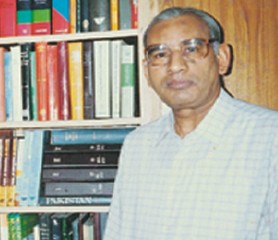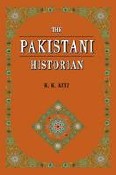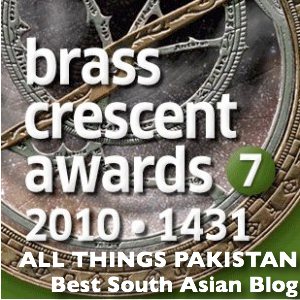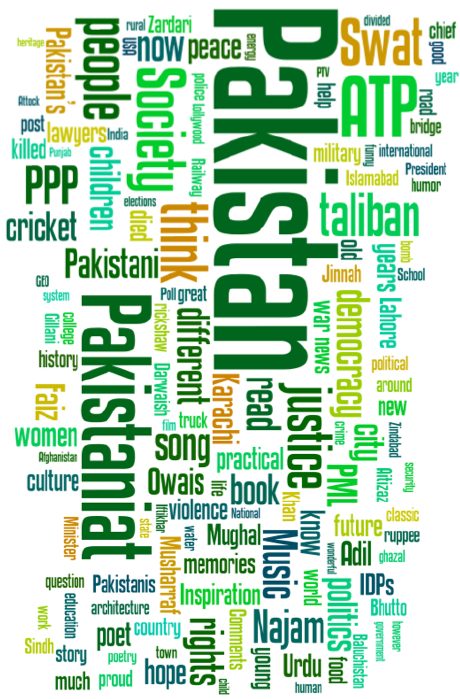Adil Najam
 One of Pakistan’s pre-eminent historians – Khursheed Kamal Aziz – died Wednesday after a prolonged illness. His courageous scholarship and honest attention to detail shall be sorely missed by all students of Pakistan history.
One of Pakistan’s pre-eminent historians – Khursheed Kamal Aziz – died Wednesday after a prolonged illness. His courageous scholarship and honest attention to detail shall be sorely missed by all students of Pakistan history.
For those who knew him and his works K.K. Aziz was a giant. Too many Pakistanis today will not know who KK Aziz was. That is their loss. Indeed, that is all our loss. As is his demise.
The news report in Dawn gives some, but only some, details on the man and his life:
Khurshid Kamal Aziz was an outstanding historian and a prolific writer. He authored a large number of books that opened up angles on history and culture sought to be concealed by official chroniclers. Quite aptly, one of his famous works is titled ˜The Murder of History”.
K.K. Aziz’s was an expansive canvas and while he has to his credit books such as ˜History of the Partition of India’, ‘The Meaning of Islamic Art: An annotated bibliography’ and ‘Public Life in Muslim India: 1850-1947’, he also came up with volumes on some important individuals who helped shape history in the subcontinent at critical junctures – among them Sir Agha Khan III and Chaudhry Rehmat Ali.
The Coffee House of Lahore: A memoir 1942-57 is his gift to the city which had helped him determine his own place in history. His autobiography is titled The Pakistani Historian. He is mainly known for his English writings but he was equally at ease with Urdu prose and a staunch believer in the power of Persian to enlighten a seeker of knowledge. In his Urdu work Woh Hawadis Aashna, he focuses on his father and his family’s history.
Son of Barrister Abdul Aziz, a well-known historian in his own right who added to his fame by initiating pioneering work on Heer Waris Shah, K.K. Aziz was born in the village of Ballamabad near Lyallpur (now Faisalabad) on December 11, 1927. He studied at the Government College, Lahore, where his teachers included Ahmed Shah Bukhari Patras and Prof Sirajuddin. He went on to teach at Cambridge, Oxford, Manchester, Toronto, Khartoum and Heidelberg. His research enriched by the exposure abroad, he would return to his country to work on extremely difficult themes that brought out the best in him – and quite often the worst in self-employed minders of Pakistan’s ideology.
In 1978, he was working as the head of the National Commission of Historical and Cultural Research in Islamabad when he was forced to leave Pakistan by the Ziaul Haq regime that was anathema to independent scholarship. This was followed by teaching assignments in England, Germany and Sudan before he finally settled in Lahore some years ago, writing profusely and frequently undertaking foreign tours.
His wife Zarina Aziz told Dawn that he had been ill for almost five years, but still worked for 10 hours a day. He was hospitalised on May 11 and discharged on June 13. He was again admitted to hospital on Tuesday, where he passed away on Wednesday. Mrs Aziz says that her husband had written 50 books and used to say that his books were his children and would keep his name alive.
His books include: The Making of Pakistan: A Study in Nationalism, Studies in History and Politics, Party Politics in Pakistan 1947-1958, Britain and Pakistan, Britain and Muslim India, Muslims under Congress Rule 1937-1939: A documentary record, British Imperialism in India and The All India Muslim Conference 1928-1935: A documentary record.
I found a delightful excerpt about Lahore from his autobiography, noted above, posted by blogger and historian Manan Ahmed. It is worth reading for many reasons, and by one and all:
From the 1920s onwards, perhaps even earlier, Lahore was the most highly cultured city of north India. From here appeared the largest number of Urdu literary journals, newspapers, and books and two of the best English language dailies. The Mayo School of Arts was flourishing. The Young Men Christian Association was active and its premises and halls were used by all communities for literary and social activities. The Government College was a distinguished intellectual center whose teachers were respected and students considered to be the best representatives of modern Western education. The Oriental College was engaged in first class research. The annual plays staged at Government College and Dyal Singh College were awaited by the city’s elite with high expectations. Eminent journalists and columnists wrote for newspapers and graced literary gatherings. The city rang with the echoes of the poetry of Faiz Ahmed Faiz, Noon Meem Rashid, Hafeez Jallandhari and Akhtar Sherani. The Niazmandan-e Lahore, the magic circle of A. S. Bokhari, Abdul Majeed Salik, M. D. Taseer, Hafeez Jallandhari, Sufi Tabassum, Syed Imtiaz Ali Taj and Hari Chand Akhtar, created enormous waves in the world of Urdu literature.
The well-to-do Westernized elite drank and danced and talked in the Gymkhana and Cosmopolitan clubs. The home-grown dazzling lights set off their fireworks at the Arab Hotel, Nagina Bakery, Mukham Din’s teashop, Halqa-i Arbab-e Zauq, India Tea House and India Coffee House. The greatest in the land, like Tagore, came and spoke at the SPSK Hall. Political debates were held at Bradlaugh Hall. Amrita Sher Gill painted and B. C. Sanyal sculpted. The best British and American films were screened at Regal and Plaza. There was even a school of ballroom dancing on the upper storey of Regal. The baithaks in the walled city trained musicians and singers and invited the connoisseurs to come and listen to the classical music. The radio came a little later and the literati wallowed in a new channel which immediately enlarged the circulation of what they wrote, said or composed.
A glorious physical setting for this pulsating intellectual activity was provided by the Lahore that the British built between 1860 and 1935. Impressive edifices adorned the landscape: Lawrence Hall, Chief’s College, Government House, High Court, Masonic Lodge, Legislative Assembly, General Post Office, Museum, Mayo School of Art, Government College, and Central Training College. The queen of all roads, the Mall, was bordered by tall trees and wide footpaths, and boasted a glittering array of expensive shops. The Race Course and the Lawrence Gardens were the lungs of the city. No high rise buildings existed. With no encroachments the roads looked wider. The bungalows of Davis, Empress, Egerton, Queens and Jail Roads were elegantly located in the middle of green lawns. The skyline was soothing. Nature’s green was the dominating color of the city. Breathing was easy, and so was enjoying life.
K. K. Aziz. The Coffee House of Lahore: A Memoir 1942-57. (Lahore: Sang-e Meel Publications, 2008): 6-10.
The Daily Times carried an apt editorial commentary of KK Aziz’s demise (I suspect, but cannot be sure, that the editorial was written by Khalid Ahmed, himself a connoisseur of all things intellectual):
Khursheed Kamal Aziz (1927-2009) who died on Wednesday was in the classical tradition of historians with the native instinct of a ferret and untrusting of anything that was not substantiated by written records. He carried a lot of his desiderata with himself and had thankfully advanced technologically as far as a word processor, a feat not many of his age have been seen to accomplish. He had to be reclusive because he was naturally prolific and could undertake the writing of three or four books at the same time. His interests were wide-ranging although history came first and he gave an account of himself writing it. But surprisingly he had enough time too to write on art and compile his favourite lines from Urdu and Persian poetry.
The trauma that happened to KK was his alienation from the grand narrative of the Pakistan Movement. And when he realised that he had been following the context of ‘my country right or wrong’ he produced in the early 1990s his two volumes on the lies that Pakistani history textbooks had been spreading to poison the popular mind. In the late 1990s, when the textbooks were challenged by some Pakistani academics, their doyen was KK, the alienated historian who admitted that he had ghost-written Ishtiaq Hussain Qureshi’s The Struggle for Pakistan and had slanted facts to favour the nationalist version of history. His investigation of the career of Chaudhry Rehmat Ali remains a classic, divorced from the official narrative of the man who had turned against the Quaid.
KK had 50 books to his credit, and a Sitara-e-Imtiaz that he returned because he was not treated well by the government. KK was sitting on top of a roomful of the preparatory works of the Hamoodur Rehman Report when he was unceremoniously kicked out of the Pakistan Commission for Historical and Cultural Research by General Zia and made to flee the country. One can be sure that he would have produced the book that Pakistan deserved after the debacle of East Pakistan, had he stayed on. Dispassionate as a historian, he was an extremely sensitive and emotional man in private life, but always rewarding as a conversationalist during a relaxed evening with his admirers.
He was a good and great man. May his soul rest in peace.




















































May Allah grant peace to the departed soul. K K Aziz was a scholar of great standing and a fair and fearless historian. His endeavour was to place the history in it’s unabashed and unbiased form before the reader. Obviously in our country the small men who styled themselves to be the champions of freedom struggle and became keepers of the invented nazariyas , resorted to distorting history in the post independence Pakistan.K. K Aziz boldly exposed such distortions and tried to educate the people of Pakistan by producing the facts and the historical records before them. It is unfortunate that his crusade has come to an end. However it is certain that his works will continue to be used as reference by the next generations.
We have lost a great histrian, an eminent scholar and a great human being. God bless his soul.
KK Aziz was truly one of Pakistan’s foremost historians but he was amongst the many remarkable men who the state of Pakistan never gave their due because of their intellectual independence, ideological leanings and /or personal integrity (Eqbal Ahmed, Habib Jalib, Dr. Abdus Salam etc.). The pygmies who have run the state since its independence have always favored sycophantic mediocrities or ideological lackeys.
His autobiography detailing some of his family history and the remarkable exposure he had to intellectual giants of the sub-continent (who were friends of his father) make for fantastic reading.
Thanks for the post honoring him.
Addendum to the last post.
Timeline of Events:
The first session of the Constituent Assembly of Pakistan was held on August 10, 1947 at the Sindh Assembly Building. On August 11, Jinnah was elected unanimously as the President of the Constituent Assembly of Pakistan and the National Flag was formally approved by the Assembly.
The speeches by Jinnah and Mountbatten at Sindh Assembly and the transfer of powers were marked on the 14th. Jinnah assumed these powers in his legal capacity of the President of the Constituent Assembly of Pakistan and the Governor General nominee.
Jinnah, being a strict constructionist, took official oath of office of the GG of Pakistan on August 15, 1947. Mian Sir Abdur Rashid, Chief Justice of Pakistan, took oath of office from him in accordance with the Indian Independence Act 1947. His speech the
On the question of Pakistan
Adil,
KK sahib was my father’s (Waheed-uz-Zaman’s) first cousin and indeed quite an incredible historian. I have had the pleasure of meeting him, both in academic and family settings and while I may not have agreed with him on every occasion, I have always been impressed by the depth of his knowledge and the strength of his arguments.
He was writing a multi-volume autobiography – the most recent volume that appeared mid last year was “The coffee house years” — there is a condensed urdu version called “hawadis aashna” as well. I highly recommend it.
May his soul rest in peace.
-Hamid